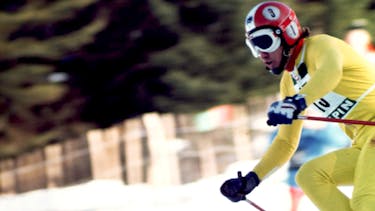Fischer makes its mark in top-class sport in the following years, too, and provides key ideas and basic organisational principles for modernising the structure of competitive sport in the Austrian Ski Federation. In 1971 the Austria Ski Pool is launched, with organisation charts and job profiles worked out at Fischer. Rudolf Jungwirth, head of Fischer’s organisation department at the time, invests several days in this task. At the bar in a Munich hotel, Ernest Simharl complains to the designer Rudolf Ferch that ski racing in Austria has no easy-toremember symbol – upon which Ferch comes up with a conventionalised eagle plus an “A” for Austria. Inside the company racing is seen as well worth investing in; at this point the budget for racing is around 13 million Austrian schillings. In the early 1970s Alfred Sturmberger, head of sales and married to Josef Fischer’s sister Selma, states in an interview: “We want to exploit racing as a powerful advertising medium, because we realise that racing victories make a huge difference to our success in selling our products. We have made great efforts internationally – in racing since around 1970. We still regard downhill as the ultimate in Alpine racing, which is why we concentrate on it so much. And we believe that by the 1976 Olympics we ought to be in a position to … Though it doesn’t have to be an Austrian. We’d prefer that, of course – but at any rate a Fischer skier.”
In the end it was a Fischer skier, and an Austrian at that. And the Austrian in question was to play a key role in downhill racing in the 1970s: Franz Klammer, the Austrians’ hero at the 1976 Olympics in Innsbruck. The man from Carinthia notches up the first of 25 downhill wins in total on the Planai in Schladming – he is then 20. With an average speed of 111.251 km/h, this stays the fastest World Cup race ever for quite some time. From then on Klammer dominates downhill racing; he wins eight races in the 1974/75 season and goes on winning in the 1975/76 Olympic season. Klammer wins the last difficult race before the Olympics, too, on the Streif in Kitzbühel. In the years leading up to Innsbruck 1976 Fischer does everything possible to make the young skier into a good glider, too. For testing purposes Hans Stroi from the development department has sensors fitted to the ski’s edges and small lights placed on its upper face. If Klammer edges too much, and especially where there’s no need, a light goes on. “It took three whole years for him to get the hang of gliding, until he became a good glider. We knew that in a downhill race the ski can make three seconds’ difference, but the skier five,” Stroi points out.
Then the great day: 5 February 1976 – the Olympic downhill race in Innsbruck. With his previous successes Franz Klammer is a clear favourite to win, but the conditions are tricky. “For years we did everything to teach Franz to glide. And now, at the end of January 1976, we are faced with an ice-hard run with lots of turns. Forty seconds of gliding early on, then one turn after the other. If he doesn’t reach the gliding section at top speed, it doesn’t matter how well he stands on the skis – there’s no way Franz can win the race. We knew that, and so did he. In every single training run he lost about a second and a half”, Hans Stroi recalls.
All the ski manufacturers are hard at work to provide their racers with the best possible equipment for the Olympic downhill. Josef Fischer confirms his intention of using an entirely new ski in the downhill race. Soon after, the secret is out: it’s a ski with a hole in the tip. Franz Klammer will use it, and maybe succeed in gaining the missing tenths of a second as a result. This ski with a hole, later to become a legend, has physical advantages: during a downhill race any ski is subjected to thousands of impacts, which act on the tip of the ski. The less the tip weighs, the less these impacts affect the ski and the racer’s body. And the loss of time is correspondingly less, too. In dozens of test runs Franz Klammer convinces himself that the ski with a hole is faster. But Klammer hesitates to use it in the Olympic downhill. What if the hole catches somehow, what if it just gets in the way the whole time? Klammer decides against the new development.

The race (in which Fischer has invested millions of schillings) begins. With 60,000 people watching, Klammer’s rival Bernhard Russi from Switzerland, the Olympic victor in 1972, goes into the lead with the fastest time. Franz Klammer starts as number 15 at 12.45 p.m. In the top section he goes ahead by four-tenths of a second. In the mid section he drops one and a half seconds behind the target time in the training runs, but in the actual race he manages to reduce this to seven-tenths of a second. But then he simply whirls through the air. Toni Sailer, the coach, shouts into the radio: “All over, Franz is out of it!” But Klammer doesn’t fall, skis into the finish with absolute precision, gains speed from leaning back and exploits the impetus. With a time of 1:45.73 minutes he finishes ahead of Bernhard Russi. Klammer’s feat makes him the “ski kaiser” and the Austrians’ hero. The gold medal gives him self-confidence and inner security. After this triumph with a conventional ski he goes on to achieve remarkable successes with the Fischer Hole Ski for two more seasons. And Fischer secures its reputation as the number one in the prestigious Alpine downhill discipline for years to come.




